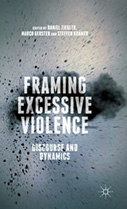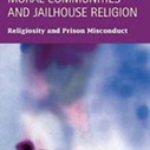FRAMING EXCESSIVE VIOLENCE: DISCOURSE AND DYNAMICS

Editors: Daniel Ziegler, Marco Gerster, and Steffen Krämer
Publisher: Houndmills, Basingstoke, Hampshire, UK; New York: Palgrave Macmillan, 2015. 263p.
Reviewer: Jared Del Rosso | January 2017
The individual essays of Framing Excessive Violence are stubborn; they are reluctant to accumulate into a whole greater than themselves. This took me by surprise. Framing Excessive Violence, edited by Daniel Ziegler, Marco Gerster, and Steffan Krämer, promises coherence. Its focus is singular: acts of violence that “resist strategies of normalization” that would assign meaning and attribute “causes and motives” to those acts (p. 2). These acts – what the volume takes as excessive violence – transgress “interpretive frameworks,” eliminating “any connection to the social realm, undermining the very possibility of societalisation” (p. 2).
But the first part of the volume, which focuses on the dynamics of excessive violence, betrays this definition. Taken together, the volume’s first six essays suggest that for the sociologist, the criminologist, the psychologist, there is no such thing as excessive violence. Our scholarship socializes violence, offering new interpretive frameworks that necessarily order and explain it. Massacres and police riots? Situational forward panics, according to Randall Collins and Anne Nassauer. The “unrestrained” violence of Neo-Nazi youth? Bernhard Giesen argues that it can be explained as most acts of youthful violence can be—as the outcome of perpetrators’ identification with aggression, often because of childhood exposure to familial violence. Rampage shootings? Intimate massacres, according to Jack Katz, in which perpetrators shed old identities by targeting the institutions that imposed those identities.
To be sure, there is considerable value in the individual essays of the book’s first section. Collins’ essay, for instance, offers a concise, coherent explanation of one-sided violence. Unrestrained, interpersonal violence – in which perpetrators physically overwhelm victims – is the outcome of situational conditions, namely a prolonged building of tension between perpetrators and potential victims, followed by a sudden turning of the exchange, so that one side senses its ability to physically and emotionally dominate another. Nassauer’s subsequent essay on police riots, in which police respond to protests with indiscriminate violence, offers a compelling empirical illustration of this thesis. And Ferdinand Sutterlüty’s essay, “What the Situation Explains: On Riotous Violence,” challenges these accounts by investigating how extra-situational factors set the conditions for violent encounters to occur in the first place.
Katz’s essay on mass shootings, which closes Part I, is particularly provocative. In it, Katz shows how identity, place, and violence intersect in rampage shooting. We should not understand these shootings as acts of revenge; revenge would, after all, target specific people who had committed identifiable offenses against the perpetrator(s). Instead, the indiscriminate killing of the rampage shooter simultaneously undoes an identity that the shooter has come to abhor and targets the place that conferred that identity. School shootings are acts that transform the self by negating it, which, Katz argues, helps us make sense of the fact that shooters rarely have escape plans and frequently take their own lives at the end of their rampage.
Still, the explanations – often powerful – offered in the book’s first section seem to me to subdue “excessive” violence. Under the gaze of social scientists, “excessive” merely becomes “extreme,” a shade of normal violence and, so, intelligible. Not quite rational, but nearly so. Gerster, Krämer, and Zieglet sense this. In their introduction, they write that the act of “framing excess” violence “must remain a paradox because the frame’s tension is created by the very delimitation that is inherent in the semantics of excess” (p. 7). That this paradox extends to the book’s own essays, which themselves frame excessive violence, is not addressed in a meaningful way. Had it been, the volume might have reflected on the role of the social sciences in providing broadly recognized interpretive frameworks for reconstructing extreme acts of violence.
Part II of Framing Excessive Violence addresses discourse. The first three essays of the section focus on rampage / mass shootings and, so, are in dialogue with Katz’s essay. Two of the essays are of particular note. Jorn Ahrens, in “German Rampage: Social Discourse and the Emergence of a Disturbing Phenomenon,” examines how German media framed two school shootings: a 2002 shooting in Erfurt and a 2009 shooting in Winnenden. Ahrens effectively shows how a “set routine” (p. 148) for media responses to school shootings developed in the seven years that passed between the shootings. In 2002, public responses to the Erfurt shooting were halting and uncertain; “most […] were struggling to find the right words” and to evoke the appropriate emotions (p. 145). Subsequent shootings, on the other hand, received “an almost automatic reaction” (p. 145). Perpetrators’ mental states and fondness for guns receive attention, seeming to place them on a “one-way path to school shooter” (p. 148).
Sveinung Sanberg’s later chapter on Anders Behring Breivik shows that it is not just the public, but perpetrators themselves, who make use of cultural frames and scripts. In 2011, Breivik, an anti-Islamic and anti-multiculturalism ideologue, murdered 77 people, most of them youths attending a Norwegian Labour Party camp. Before doing so, he compiled a 1,500 page manifesto of original, recycled, and plagiarized writing, which he distributed widely. Sanberg offers a close analysis of the narrative modes of the manifesto, showing that it contains at least four: a technical mode, addressing the mechanics of terrorism, an emotional mode, passionately calling for action against the “Islamisation of Europe” (p. 183), the pragmatic mode, in which he provides modest justifications and rationalizations of his actions, and a social mode. This latter mode seems the most out of place. It often takes the form of a question-and-answer, from Breivik to Breivik, and covers topics typical of a personal diary – cologne and book preferences, impressions of cities he’s visited, descriptions of personal relationships, etc. Emoticons (e.g. “;)” and “:D”) even make appearances. Sanberg argues that the presence of the four modes challenges us to reconsider the meaning of Breivik’s act. Rather than see it as a straightforward expression of anti-Islamic ideology, Sanberg argues that the act is more ambiguous, expressing a range of cultural voices and references.
I read Framing Excessive Violence in the spring and summer of 2016, seasons marred by mass shootings. This type of extreme violence seems to have undergone a recent transformation, creeping out of schools and workplaces and into nightclubs and city streets. Katz’s, Ahrens’, and Sanberg’s essays help us better understand these horrific acts than do the now-rote public responses of most politicians and media elites. They are worthy of close attention and should enrich conversations about mass shootings.
Framing Excessive Violence closes with three chapters on state violence and international conflict: Werner Binder’s essay on Abu Ghraib, Annette Vowinckel’s essay on photographs of torture, and Jan Klabber’s essay on international law. Read together, Binder’s and Vowinckel’s essays on torture well-illustrate the tension inherent in the notion of “framing excessive violence.” On one hand, Vowinckel argues that the relative dearth of photographic representations of torture, particularly when compared to the relative commonness of photographs of war, suggests that we “lack…a visual reference and cultural framing” (p. 233) of the practice. On the other hand, Binder’s essay shows the relative ease with which American politicians were able to frame Abu Ghraib – as the result of a “few bad apples” or “weak leadership” (p. 214). Initially, the events at Abu Ghraib reduced American political elites to admissions that they lacked the words to discuss the photographs. Then-Secretary of Defense Donald Rumsfeld implored Congress, “If you could have seen the anguished expressions on the faces of those in our Department upon seeing those photos, you would know how we feel today,” while a spokesperson for President George W. Bush described him as simply having “shook his head in disgust” after viewing then-classified photographs from the prison (quoted in Del Rosso [2015, p. 47-8]). But Abu Ghraib was quickly ordered, and the words came. The photographed events at the prison expressed, to quote James Schlesinger, “Animal House on the night shift,” an isolated incident caused by a few bad apples (quoted in Del Rosso [2015, p. 92]. Much as Germans learned to frame mass shootings, Americans learned to frame acts of torture that, once, caught us off guard.
There are, then, latent points of contact among Framing Excessive Violence’s essays. But I found these points organized around the topics or cases the essays took up: situational violence, mass shootings, torture. “Excessive violence” remained in the background, largely superfluous to the arguments of the volume’s contributors; indeed, the essays contribute more to the study of their cases than to “excessive violence” itself. A concluding essay that pursues the synthesis that Philip Smith, in his blurb for the volume, suggests “might be just around the corner” could have helped the reader along. Despite this, the essays of Framing Excessive Violence are timely, helping readers make sense of the (seemingly) unfamiliar violence of 2016. And the paradox that the volume identifies – that excessive violence transgresses social and moral codes and yet eventually becomes tamed by them – is provocative and worth further exploration.
Jared Del Rosso, Assistant Professor, Department of Sociology & Criminology, University of Denver
Reference:
Del Rosso, J. (2015). Talking About Torture: How Political Discourse Shapes the Debate. New York: Columbia University Press.


